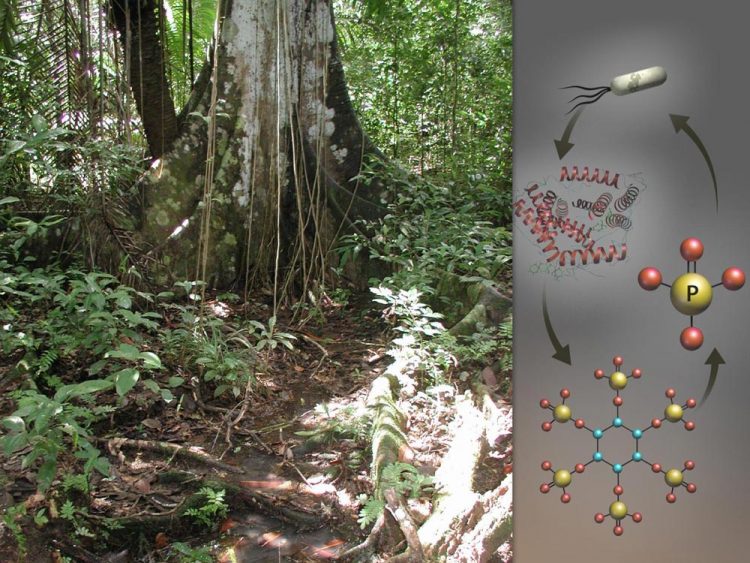Researchers reveal how microbes cope in phosphorus-deficient tropical soil

An Oak Ridge National Laboratory-led research team found genes for production of phytase enzymes that would be released by tropical soil microbes. Phytase enzymes will attack phytate molecules, releasing much needed phosphate molecules for the microbes' survival. The soil samples were collected in phosphorus-rich and -poor experimental sites at the Smithsonian Tropical Research Institute in the Republic of Panama. Credit: Melanie Mayes and Andy Sproles/Oak Ridge National Laboratory, U.S. Dept. of Energy
Phosphorus is a critical nutrient for global biological processes, such as collecting the sun's energy during photosynthesis and degrading plant debris and soil organic matter. Most tropical ecosystems endure long-term weathering that leaches phosphorus from soil.
The ORNL-led team set out to discover how soil microbial communities respond to the lack of phosphorus and other nutrient deficiencies at the molecular level.
They collected soil samples at the Smithsonian Tropical Research Institute in the Republic of Panama, an experimental field site with phosphorus-rich plots and unfertilized control plots.
“This was the perfect place to test the optimal foraging theory, which is a model that helps predict an organism's behavior when searching for resources,” said Chongle Pan, ORNL senior staff scientist and joint associate professor at the University of Tennessee. “We learned how this theory plays out when applied to microbial communities as they compete for nutrients.”
The team analyzed the behaviors of many genes and proteins, and in the phosphorus-deficient, untreated soil, they found an increased number of genes responsible for producing phosphorus-acquiring enzymes. They also discovered more than 100 genes that work to pull phosphorus from phytate, which is a complex organic compound found in plant tissue.
“Finding so many genes to break apart and transport such a complex molecule tells us that microbes are hungry for phosphorus in untreated soil,” said Melanie Mayes, an ORNL senior staff scientist who studies multi-scale environmental processes.
Conversely, she noted that when phosphorus was plentiful, more genes needed to acquire complex carbon compounds were present. “The microbial community prioritizes the breakdown of the most needed nutrients, focusing efforts on the most limiting element to balance their overall nutritional needs,” she said.
The team ran each soil sample through a series of rigorous and comprehensive analyses. The DOE Joint Genome Institute conducted deep sequencing of the soils' metagenomes, or genetic material recovered directly from the soil. ORNL then used mass spectrometry and metaproteomics to identify more than 7,000 proteins in each sample.
ORNL's Titan supercomputer quickly analyzed the large amounts of metagenomics and metaproteomics data, comparing microbial activities in phosphorus-rich and -poor soils. Environmental Molecular Sciences Laboratory scientists further characterized the soils' organic matter at Pacific Northwest National Laboratory.
These unique tools working together enabled one of the deepest proteogenomics studies done on soil microbial communities, according to Pan.
The ORNL-led team plans to continue their research to characterize the ecology and evolution of soil microbial communities in nutrient-poor environments, which has applications in agriculture and terrestrial biosphere modeling worldwide. Additionally, Mayes and her team are incorporating metagenomics information into nutrient cycling models under a DOE Early Career Research Program Award.
###
Results from their three-year study titled, “Community Proteogenomics Reveals the Systemic Impact of Phosphorus Availability on Microbial Functions in Tropical Soil,” were published in Nature Ecology & Evolution.
The paper's coauthors included Qiuming Yao, Zhou Li, Yang Song, Melanie A. Mayes and Chongle Pan of ORNL; S. Joseph Wright and Benjamin L. Turner of the Smithsonian Tropical Research Institute; Terry C. Hazen, University of Tennessee-ORNL Governor's Chair for Environmental Biotechnology; Xuan Guo of UT; Susannah G. Tringe of the DOE Joint Genome Institute; and Malak M. Tfaily and Ljiljana Paša-Tolic of Pacific Northwest National Laboratory.
The research was supported by the Laboratory Directed Research and Development program at ORNL. Metagenomic sequencing was conducted by the DOE Joint Genome Institute and soil organic matter analyses were performed using Fourier-transform ion cyclotron resonance mass spectrometry by PNNL's Environmental Molecular Sciences Laboratory, both DOE Office of Science User Facilities. This work also leveraged the Oak Ridge Leadership Computing Facility, a DOE Office of Science User Facility.
ORNL is managed by UT-Battelle for DOE's Office of Science. The Office of Science is the single largest supporter of basic research in the physical sciences in the United States, and is working to address some of the most pressing challenges of our time. For more information, please visit http://science.
Media Contact
All latest news from the category: Earth Sciences
Earth Sciences (also referred to as Geosciences), which deals with basic issues surrounding our planet, plays a vital role in the area of energy and raw materials supply.
Earth Sciences comprises subjects such as geology, geography, geological informatics, paleontology, mineralogy, petrography, crystallography, geophysics, geodesy, glaciology, cartography, photogrammetry, meteorology and seismology, early-warning systems, earthquake research and polar research.
Newest articles

First-of-its-kind study uses remote sensing to monitor plastic debris in rivers and lakes
Remote sensing creates a cost-effective solution to monitoring plastic pollution. A first-of-its-kind study from researchers at the University of Minnesota Twin Cities shows how remote sensing can help monitor and…

Laser-based artificial neuron mimics nerve cell functions at lightning speed
With a processing speed a billion times faster than nature, chip-based laser neuron could help advance AI tasks such as pattern recognition and sequence prediction. Researchers have developed a laser-based…

Optimising the processing of plastic waste
Just one look in the yellow bin reveals a colourful jumble of different types of plastic. However, the purer and more uniform plastic waste is, the easier it is to…



